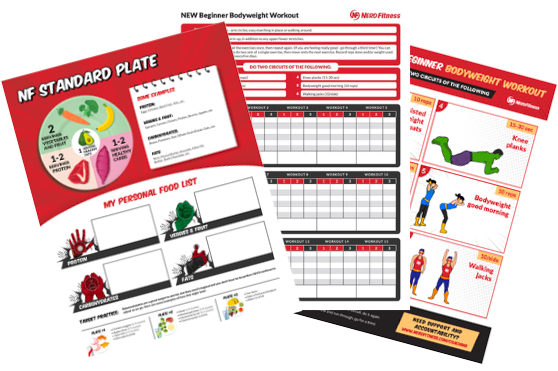
Looking to run your first 5K? You’ve come to the right place.
In today’s guide, we’ll cover common questions – and 5 mistakes – about running your first 5k, and avoiding all the mistakes most people make:
- Why are 5k Training Plans so popular?
- Analyzing popular 5k Training Plans
- What is the best 5k Training Plan?
- “Will I lose weight running a 5K?” (Mistake #1)
- “Do I even like running?” (Mistake #2)
- “Am I healthy enough to run a 5K?” (Mistake #3)
- How to start (5K Schedule and PDF)
- “How do I not hurt myself running a 5K?” (Mistake #4)
- 10 tips and tricks for running a 5K
- “What do I do after Running a 5K?” (Mistake #5)
- “What if I own a futon? Can I still do Couch to 5K?”
Blog: 5k Training Plans
12-week training plans for all levels. Whether you want to walk your first 5k or improve your running times, we've got a plan for you.
Why are 5k Training Plans so popular?

To make sure we’re all talking about the same thing, a “5K” is a race that’s 5 kilometers long (roughly 3.1 miles).
Running 5Ks exploded in popularity thanks to “Couch to 5K,” a free program that takes people from their couch to running a 5K race in 9 weeks.
This running program was invented by Josh Clark of CoolRunning WAY back in the day.
It has since been co-opted and copied by every running blog out there, so we’re going to be referring to a generic “5K Training” program when we talk about it.
(When people ask the question “How long does it take to complete Couch to 5K,” it really depends on which program they pick.
It might be 6 weeks, or 12 weeks, or 9 weeks. The original Couch to 5K plan created by Cooling Running took 9 weeks).
We have tons of clients who come to us wanting to complete their first 5k walk or run.
“Steve, I’m intrigued. Why are 5K and 5K training plans SO DANG POPULAR?”
#1) They’re simple and clear.
Print out a PDF or download an iPhone app and for the next 6-12 weeks (depending on which plan you pick) you simply do what it tells you:
Today, do this.
Tomorrow, do that.
Repeat.
We’re all busy. Most of us lead hectic lives. And programs that tell us EXACTLY what to do allow us to follow instructions without needing to figure it out ourselves.
Not that we nerds overanalyze things to the point of giving ourselves anxiety attacks…
#2) Many believe running = weight loss.
If you’re brand new to health and fitness, and you’re trying to lose weight, you’re most likely overwhelmed by what you should start with and how you should train.
Are you gonna go sign up for a gym membership, hire a trainer, and start doing squats and deadlifts?
As much as I would WISH that was the answer (it’s probably the fastest path to changing one’s physique), it’s often a bridge too far for many folks.
So a majority of newbies equate running with weight loss (which MIGHT be true, but MIGHT not, I’ll explain later), and decide to start with a walk or jog around the block.
And then they pick a goal like “Run a 5K” because…
#3) Running a 5K feels approachable.
Running a 5K feels like an obtainable goal, and thus picking a “5K training program” is the next logical step.
Most are free programs (or inexpensive apps) that feel very approachable.
Weight training programs like P90X and Insanity are designed to appeal to people who consider themselves hardcore (whatever the hell that means).
5k Training Plans appeal to people who are overwhelmed at the idea of doing P90X or Insanity or mustering up the courage to go to Crossfit.
5k plans lower the barrier to entry. They make you think “maybe I can actually do this…” which is the most important part of any fitness journey: starting.
#4) Everybody wants to “have run a 5K.”
If you’re new to health and fitness and working on setting a good obtainable goal, “run a 5K this year” is a great place to start.
- It’s a short enough distance that with some training you can pull it off, even if you have to walk some or all of it.
- There are 5K races every weekend, many of which raise money for charity or are themed in a fun way.
- It’s an amazing activity to do as a group with friends.
- Humans are wired for achievements, progress, and gratification – 5Ks are perfectly designed for that.
So in completing a 5K, you train and get to see yourself progress weekly, you get to finish a race feel a sense of accomplishment, and you go home with a medal you can hang on your wall reminding you of the proud moment.
Plus, it might get you in shape!
(Maybe…we’ll explore it in just a moment.)
This sense of progression is one of four key elements we’ve found in our 1-on-1 Online Coaching Program that helps people stick with a program long enough to see results.
Analyzing popular 5k Training Plans
Here are the two most popular types of 5K Training plans in a nutshell:
1) Interval Training
Many programs use a concept called interval training – moving at different speeds throughout a running session. For example, your running workout might consist of 30 seconds of jogging, followed by 2 minutes of walking, repeated 6 times.
Varying your pace this way does a few things:
- Helps push you outside your comfort zone. You’re able to push harder for short ‘sprints’ within an interval training workout, which allows you to work at a higher level of relative intensity.
- Keeps workouts short and sweet. Because we are operating at a higher intensity level, interval workouts tend to be shorter than their steady-state cardio counterparts.
- Teaches you what it feels like to run at different paces and speeds. Could you train at different paces and speeds using steady-state cardio? Sure. However, the variance in speeds with interval training tends to help beginners experience different pacing structures.
- Improves your general conditioning and endurance. Your heart and lungs have to adapt to the various levels of strenuous activity (and get stronger/healthier as a consequence.)
- Introduces a bit of novelty into your training – which can help you stick to it. When people first start a program, often the most important factor is sticking with it consistently to see results.
Over the weeks, 5K Programs slowly ramp up the amount of time you spend running and cut back the time you spend walking until you’re at the point where you can actually run a 5K without stopping. (At least, that’s the idea!)

However, there are limitations to a training program based solely on interval training:
- Interval training causes more fatigue. Because it’s done at bursts of higher intensity, interval training can cause more fatigue. This works great if you are short on time, but it’s important to know it’s a trade-off of being able to train MORE (which has its own benefits.)
- Preparing for race day. While you can absolutely use intervals at your 5k race, if you want to walk or run the race at a consistent pace, doing more training that mimics that exact pace is beneficial.
- Enjoyment. You may find you just don’t enjoy interval training as much as other forms of training. That’s a completely valid reason to do something else.
As a general rule of thumb, we’ve found interval 5k plans to be great for beginners, and for those short on time to train throughout the week.
As you get familiar with endurance training, we recommend including some longer runs in your training. Which conveniently leads us to our second type of 5k plan:
2) Steady-state Training
In a steady-state training plan, you’ll be given a specific time or distance to go out and walk or jog. An example would be “Jog for 20 minutes” or “Walk 1.5 miles.” Your goal is to maintain about the same pace for the duration of your workout that day.
Having a steady pace like this does a few things:
- Improves your general conditioning and endurance. Yup, just like interval training, steady-state training is great for general conditioning and endurance. (* This study showed steady-state and high-intensity interval training to be equally effective for endurance. https://www.ncbi.nlm.nih.gov/pmc/articles/PMC4657417/)
-
- Easier to track pace. Since you are running at a consistent pace for the duration of your training, it’s much easier to track your pace and see improvements in your speed over time.
- Scales to longer distances. Because you can train at a lower relative intensity than interval training, you are also able to train longer distances and times. As you get to a more intermediate/advanced level of training, adding more total time spent training is a key component of progressing further!
- Easier to stay in Heart Rate Zones. Heart rate training is another effective way to monitor your intensity and improve your endurance training. By maintaining your heart rate in a specific “zone”, you can target the appropriate intensity for your session. Because interval training is start/stop, it can be much harder to regulate your heart rate in the time given.
Steady-state 5k plans can be great for beginners who enjoy them more than interval training, and for intermediate and advanced trainees who need to work with longer distances or heart rate training to see further improvements.
What is the best 5k Training Plan?
The simple answer: the one you actually stick with!
I know, I know, that’s not the answer you are looking for. But don’t worry, we can do one better! Here are the exact criteria one of our coaches uses to evaluate programs for their clients:
- Is it a program you’ll actually do? The best training program in the world doesn’t matter if it doesn’t fit with your schedule, life, and preferences. The best program is one that you can do, consistently.
- Is the program specific to your starting point and goal? Too many programs are one-size-fits-all. We know that’s not how the best training programs work. Instead, they should take into account your starting point (training age, etc.) and your specific end goal (run a 5k in X minutes, walk your first 5k, etc.) and draw the clearest line from Point A to Point B possible.
- Are you able to recover from the training in time for the next session? This is probably the most overlooked part of a good training program. YOU NEED TO BE ABLE TO RECOVER BEFORE THE NEXT SESSION. If the training times and distances are too high, you’ll continue to be sore for your next session, which means you won’t be able to train to the best of your ability and can lead to overuse injuries down the road.
- Are you seeing steady, maintainable progress? On the other hand, the training program needs to challenge you ENOUGH that you see steady progress, week in and week out – without burning yourself out.
The truth is – there are tons of great programs out there that can work.
Couch to 5k apps, Run! Zombies!, and Hal Higdon all provide great places to start.
Looking for a program that incorporates all the things we’ve talked about so far? Check out our 5k Training Templates – completely FREE.
We’ve divided them into different levels so you can pick your exact starting point and goal Whether you want to walk your first 5k, run your first 5k, or improve your overall times, we’ve got you covered. Snag our templates by signing up for our newsletter in the box below.
Will I lose weight running a 5K?

“Steve that’s all fine and good. But what do you REALLY think about running 5Ks and Couch to 5K?”
Okay, you got me. I got thoughts. I also got jokes (they’re bad).
RANT INCOMING!

Will the Couch to 5K program help you run a 5k? YES! If you actually stick with it for the entirety of the training program.
Will the Couch to 5K program help you lose weight? MAYBE.
Is Couch to 5K a program that will get you healthy? MAYBE.
Will Couch to 5K make me sexy and look damn good in a bathing suit? MAYBE.
Here’s the truth about any 5K training program: It’s the same truth with popular programs like P90X or Insanity or any other structured workout program:
It totally works and will help you lose weight if you do two things:
- You actually complete the program, AND
- You address your diet.
MISTAKE #1: Couch to 5K won’t help you lose weight if you do two things:
- You complete the program, BUT
- You don’t address your diet.
As sexy as it is to think that just going for a run will help you lose weight, the data doesn’t back it up. In fact, as Time Magazine rightly pointed out years ago and got yelled at for telling the truth, exercise alone won’t make you lose weight.
As we say here at Nerd Fitness, weight loss isn’t magic, it’s math + behavior change.
If you go for a mile run and then stuff your face with extra calories “because you earned it,” you’re going to gain weight.
It’s not because you have a slow metabolism. It’s because you’re consuming too many calories.
This is Common Mistake #1: not addressing your nutrition if you’re running for weight loss!
If this were a movie, nutrition would be Tom Cruise in Mission: Impossible and exercise is the funny sidekick who helps Tom. Let’s be real here, Tom is doing all of the heavy lifting to make that movie what it is.

5k Training Programs help people run a 5K. And by doing so, improves their cardiovascular capacity and health.
That’s it!
(Of course, building cardiovascular health is pretty awesome)
A 5K training program is NOT designed to help you lose weight or build muscle. It’s a temporary program that lasts a certain number of weeks until you run your 5K.
For Couch to 5K to be successful long term, and for it to help you lose weight, it needs to be the catalyst for building a consistent long-term habit of exercise and changing how you think about food.
Remember: you never get to be “done”, so you need to enjoy the journey and look forward to exercising daily.
You also need to train the right way to build the type of body you want! And eat the right way.
That’s priority numero uno.
Nutrition is a really challenging, complex, controversial topic (Keto? Paleo? Ah!), which is why we make it stupidly simple for smart, good looking, modest people like yourself.
In addition to our online coaching program that guides you on making healthier food choices, we also created a free 10-level NF Nutrition blueprint you can hang on your fridge next to your Couch to 5K PDF.
Print it out, hang it on your fridge, and follow the instructions to level up! You can get yours free when you sign up in the box below:
Now that we have the “will I lose weight?” stuff out of the way, I have two BIG questions to ask you:
Do you like running?
Are you healthy enough to run?
Do I Even Like Running?

Bodybuilder Ronnie Coleman said it best:
“Everybody wanna be a bodybuilder, don’t nobody wanna lift no heavy ass weight.”
In other words: “Everybody wants to be in shape, but nobody wants to put the work in to actually GET in shape and look great.”
Yep, getting in shape is tough; if it were easy we’d all look like Captain America and Wonder Woman.
This brings me back to the most crucial question of this entire 5K process:
Do you LIKE running?
The world is split into three groups:
- People that like running and want to run.
- People that don’t like running but eventually learn to love it.
- People that don’t like running and will never like running.
Here’s that Ronnie Coleman quote, slightly adapted: “Everybody wants to have run a 5K, but many people don’t actually enjoy running.”
Running a 5K is a great achievement and a worthwhile fun goal, but it’s only one way of thousands to “get in shape.”
Many people feel like Andy Dwyer in Parks and Rec when they go running.
Some people love that feeling of pushing beyond the limits, and that’s awesome!
But for everybody else, they make Mistake #2: they force themselves to run even though they don’t like it!
Before you start Couch to 5K, think of it as a science experiment:
“I hypothesize that training for a 5K will be good for me! I’ll enjoy the process, enjoy how I feel after a run, enjoy running a 5k, and/or enjoy the achievement of having run a 5k.”
That’s all this is: an experiment to see if running is the type of exercise you want to continue doing consistently for the next few years.
If 2 weeks into Couch to 5K you’re miserable and hate it: fantastic!
You just discovered that you hate running and are now free to NEVER RUN EVER AGAIN FOREVER.
It means your science experiment produced a result that you can now use to inform future exercise decisions.
It doesn’t make you a failure.
It just means you found a type of exercise that doesn’t work for you.
If you discover you LOVE running and how it makes you feel: fantastic! You can now make running part of your regular exercise routine. You’ve found something you can do for the rest of your life.
If you are running to prove something to yourself, because a friend is doing it, because you’re raising money for charity, or anything else: fantastic! Do Couch to 5K and then decide if this is the strategy that you enjoy and want to stick with permanently.
Don’t make Mistake #2: If you’re ONLY doing this to lose weight and it’s making you miserable, quit. Don’t run. Ever.
Instead, pick an exercise you actually enjoy. Not because the exercise is going to help you lose weight – because doing an exercise you love is a constant reminder of “I’m making choices that support my goals, and thus I should probably eat to support that!”
If weight loss above all else is your goal, start with our “Beginner’s Guide to Healthy Eating.” I can promise that if you read those strategies and start to implement them in your life, you’ll see results without ever having to set foot on a treadmill.
Phew! Okay, that covers “do you actually LIKE running?”
There’s another massive question you should be asking yourself before you start…
Am I healthy enough to Run a 5K?

Just because you WANT to run doesn’t mean you SHOULD necessarily start running just yet.
It could be a fast track to injury, disappointment, and misery!
Those are literally three of my least favorite things. The fourth being mosquitos.
Back to your health: are you physically ready to run?
If you’re at or close to your goal weight, then starting a running program is a good idea.
Read the section “How to not get injured running a 5K” and get started.
If you are obese or very overweight, WALKING a 5K is a great goal for the immediate future.
However, I think Mistake #3 would be running a 5K before properly preparing your body for it! In fact, running prematurely might cause damage to your joints and ligaments and cause you to backslide a whole bunch.
WHAT I WOULD DO INSTEAD: Focus on healthy eating, build the habit of daily walks (or our walking a 5k template), and follow a beginner strength-building routine like the Beginner Bodyweight Circuit.
This will build you a solid foundation of strength, core strength, and endurance.
Here’s why you should focus on strength and nutrition before pounding the pavement with hours of running:
- As you begin to drop weight, the strain on your joints, organs, bones, etc. will start to decrease.
- As you strength train, the ligaments that hold your body together will become stronger and more adequately prepared for the rigors of running.
- As you refine your running form to minimize resistance and jarring shocks throughout your body, your body will learn to become more efficient.
- When you start to approach your goal weight, you can start to increase your speed from power walking to jogging – with the correct running technique (see below) – and stay healthy.
“STEVE, I was all excited to run a 5k, and now you have me demoralized. I’m overweight but I still want to run!”
Great! I don’t want to keep you from exercising, I want to help you build momentum and make you antifragile.
You’re an adult! If running is what you want to do, go for it!
Just read the section below on proper running technique!
I would still advise you focus your efforts on strength training, hiking, long walks on the beach…low low-impact activities that strengthen rather than deteriorate your body.
You do you, boo.
How to Start (5k schedule and pdf)
“Steve I’m in. I read all of that jazz above and I am ready to get started. Whether I’m walking or running, I want to train for a 5K!”
Here’s the walking 5k Nerd Fitness official template as well. You can grab all of our templates for free, from walking to running a 5k, when you sign up for our newsletter.
The goal is to do each week’s workout listed 3x/week.

What I would do next after downloading the program? Do the first day of training!
I would also recommend finding a race that’s 2-3 months from now, and sign up for it even if you’re not ready.
Recruit a friend or two to join you in training and the race!
Doing these things creates immediate motivation and accountability.
It’s the strategy that Jaime from Nerd Fitness used to get herself in shape: signing up for races in the future that she wasn’t quite ready for yet.
She also strength-trained and dramatically overhauled her nutrition, but she used races as great motivational events to stay on target!
HOW TO FIND A 5K IN YOUR TOWN: Let me google that for you. Type “5K + [your town]”, and I bet there’s a 5k every weekend for the rest of the year coming up. The Couch to 5K app also lists local races for you.
Here’s how you can get started:
- Pick a race that looks fun that raises money for a good cause
- Recruit a friend or two
- Go for your first day of running!
It’s gonna suck, and you’re going to be fine. You’ll get better!
This is exactly what I did years ago when I dressed up like a Caveman with 20 of my friends and raised thousands of dollars for kids with cancer to go to summer camp!
How do I not hurt myself running a 5k?
If you don’t learn how to run correctly, you’re doomed to develop an overuse injury and that’s going to negate the whole reason you started running in the first place!
This is Mistake #4: Crappy running form!
When you run, you’re putting hundreds of pounds of pressure on your joints and ligaments with each bounding step down the road.
This is then repeated thousands of times over the course of training and a race.
No wonder nearly every runner has stories of injuries they’ve had to deal with. It can be a brutal activity that can wreak havoc even with good running mechanics.
With poor running mechanics, the results are compounded.
And not the GOOD kind of “compounded” like compound interest like you learned in 2nd grade with the story about starting with 1 penny a day and doubling it every day for 30 days.
The BAD kind of “compounded” like plantar fasciitis and stress fractures and sore IT bands and torn ligaments and crazy soreness all the time.
We don’t want that.
I’m going to get super granular into proper running technique in this section, so if you already have perfect running form, you can skip this section. But I’d still read it.
Yeah, you should probably read it.
Here are the “5 Steps to Not Sucking at Running a 5K,” thanks to my friend Jason Fitzgerald of Strength Running:
1) Lean From Your Ankles
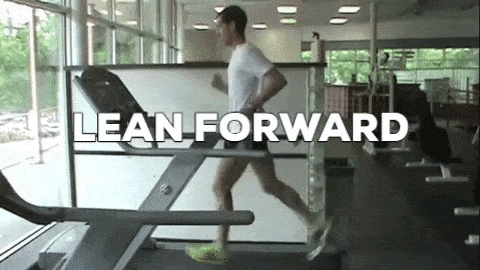
Lean from your ankles, and keep a straight line from your ankle, through your butt, and up to your head.
If you’re standing still with this slight forward lean, you should feel like you’re about to fall forward.
When you start running, gravity will help keep you progressing forward. A proper lean from the ankles keeps your body in alignment and loads your muscles properly and efficiently.
2) Increase Your Cadence
Cadence is your stride rate, or the number of steps you take per minute. It will probably seem weird at first, but you’re putting less stress on your legs with shorter foot strikes.
Your cadence should be at least 170-190 steps per minute when you’re running at an easy, conversational pace. It will probably increase once you start running faster—that’s normal.
“Steve, what the hell do I do with “170-190 steps per minute?”
Great question. Go to Spotify and look for 170-190BPM playlists, like these which I found here:
Not on Spotify? Cool. (But like, why?) To get a cadence, try running to Outkast’s “Hey Ya” and time your strides to match the beat. That’s the cadence you’re looking for:
Research has shown[2] that increasing your cadence and taking more steps (around 180 per minute) provides many of the same benefits of barefoot running: less impact shock that goes up your legs, improved running economy (or your efficiency, which means you’ll run faster with less effort!), and a reduced chance of injury.
You’ll feel like you’re taking way more steps than normal – that means you probably had poor form before and now you’re fixing it!
If your legs get to the point where they’re going this fast, let me know:

3) Foot Strike at the Right Time
When your foot comes down and makes contact with the ground, it should be underneath your body, not in front of it.
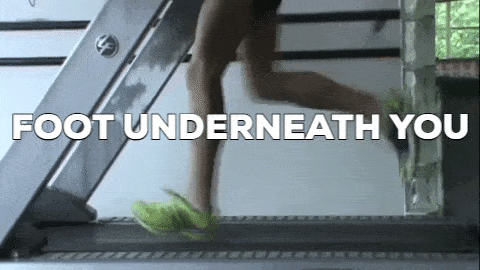
Combined with a quick cadence and a slight forward lean from your ankles, you’ll be distributing impact shock evenly—and efficiently.
This aspect of running form is often skipped over by beginning runners.
Instead of focusing on where the foot is landing in relation to the rest of the body, they focus too much on running on their forefoot. If you don’t first land in the right place, a midfoot or forefoot strike will only do more damage.
As you’re running, a good mental cue is to think that you’re just “putting your foot down” in a straight line underneath your body.
There’s no reaching or stretching your leg out in front of you. Practicing this mental cue will have your leg touching down almost exactly underneath your center of mass, distributing your weight evenly and safely.
4) Land on Your Mid-Foot
While not as important as landing underneath your center of mass, becoming a mid-foot striker has a host of benefits.
It can help you avoid a lot of injuries by absorbing impact shock and preventing a severe heel-striking running stride.
Heel-striking can’t be entirely blamed for injuries and labeled “bad.”
Even elite athletes heel strike when they run races! It’s not entirely bad— especially if you’re putting weight down on your foot just after you heel strike, instead of directly on the heel.[3]
What you should focus on is having a higher cadence, landing underneath your body, and not aggressively heel striking.
Try to land with your foot flat on the ground, instead of with your toes angled upwards.[4]
5) Symmetrical Arm Swing
Nobody wants to look at you running if you’re flailing your arms wildly all over the place like Elaine dancing from Seinfeld.

An ideal arm swing has your arm bent at about 90 degrees and a front-to-back swing (not side-to-side).
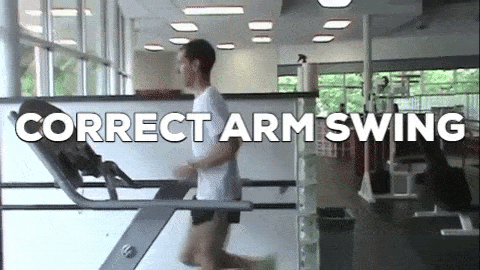
Imagine a pretend line that goes down your mid-line or center of your body. When you run, your hands should not cross over this imaginary line.
Cup your hands loosely together (no clenched fists!) and if you want to use your arms for momentum, pump your elbows, not your hands.
Once you incorporate these changes into your running form, you’ll feel a lot more comfortable and your injury risk is going to plummet.
For extra credit, learn to run softly and quietly. Foot stomping isn’t allowed and gets increasingly more difficult as you approach 180 steps per minute.
A few other things you want to keep in mind:
- Keep a tall back, chest up. No slouching.
- Look 30-50 meters in front of you – not head down looking at your toes.
Both are easy cues to keep an athletic posture and good running form.
Go back through and read this section a few more times. We know it’s a LOT to think about while running, but it is incredibly important. If you get a chance, have somebody film you running, and then watch your tape back to see how you’re doing.
10 Tips and Tricks for Training for Your 5K
Although the average 5k Training Plan covers specifically how you should be training, it still leaves out quite a few important things (like technique, which I covered above!).
Once you’ve picked your 5K training program, here’s how to get yourself to ACTUALLY follow through on your training!
#1) Recruit an accountability partner. Have somebody that trains with you (or at least somebody you tell about your training), so that each day you can check in with each other.
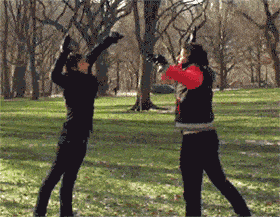
Wanna be diabolical?
Give somebody else $100 of your money. And tell them you’ll check in with them after your training every day – if you don’t do your run, they’ll donate $50 of that money to a political cause you HATE.
While you’re building the habit of running, you need to make the pain of skipping your run greater than the pain of doing the run.
Do this enough times until you build up enough momentum and get hooked on that runners high so that you actually look forward to training.
#2) Warm-up before, stretch after. Don’t do static stretches before your runs. It’s not doing what you think it is[5]. Instead, you’re going to warm up your muscles through active movement.
- Do a dynamic warm-up before you run. Continue this by going for a light jog, high knees, and warming up your muscles through movement.
- Do the following cool-down stretching routine after you run. Stretching after for the win!
#3) Make it the first thing you do each day. Build the habit of doing your run first thing in the morning when life hasn’t had a chance to get in the way.
Sleep in your running clothes.
Put your alarm clock/phone across the room. Put your running shoes by the door. By hacking your Batcave, you’ll minimize the steps between you and the new habit you’re trying to build.
#4) Strength training makes running easier. Doing 1-2 sessions of strength training per week (on days you’re not running) will help you burn fat, build muscle, and stay injury-free.
Follow our Beginner Bodyweight Routine, no equipment required!
#5) Don’t worry about your shoes when you start. Wear whatever shoes you have so that you can just get started building the habit immediately. If you START to love running, read our article on proper footwear and get yourself some better kicks.
The same is true for “running clothes.” Don’t let this be a barrier to entry.
Start running first and make sure you like it before you go spending any hard-earned cash on stuff you’re not gonna use.
Oh, and as Coach Jim mentions in the video above, DON’T RUN IN BRAND NEW SHOES!
Trust us on this one.
#6) Sign up for your race as far in advance as possible. Use 20 seconds of courage if you need to, but commit to the race.
If you don’t sign up, you’re going to be much more likely to back out when life gets busy.
But if you pay for it ahead of time, and get other people to run with you, you’re going to be using positive peer pressure to follow through on your commitments.
#7) Your race time doesn’t matter! Who cares if you’re the last person to finish? Like the Rock taught us, it doesn’t matter.

What’s important is that you finish something that you started. That’s a huge accomplishment in itself.
#8) Start a running club or join one at work – the more people you surround yourself with that are doing the things you want to do, the better. Hang out with runners that are faster than you.
You’re the average of the 5 people you associate most with, so you might as well start associating with faster, healthy runners.
#9) Don’t have an in-person running community? That’s cool! Join our private Facebook group – the Nerd Fitness Rebellion – and you can find other Nerds who are on a similar path to you!
#10) Hire a coach. Outside of having a group of friends or co-workers keeping you accountable, a coach who routinely checks in with you and your progress can be a godsend. We’ve helped tons of people build the habit of running!
What Do I do After running a 5k?

You made it through the training, and you ran/walked your first 5K! I’m so proud of you.
Gold star.
A+.
So after successfully completing your first 5K, you may be wondering what you should do next. To run again or not…
Many new runners absolutely love the atmosphere at a race; the number pick-up, pre-race motivational speech, cheering crowds, and crossing that finish line.
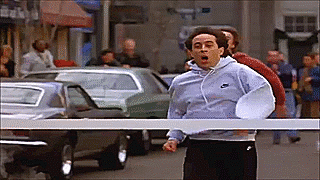
Oh, and the post-race beer and meal is the best food and drink you’ve ever tasted.
So after the excitement settles down, you need to ask what you want to do next.
Your three options:
- Run Faster: Sign up for another 5K, keep training, and try to beat your previous race time.
- Run longer: Maybe you want to run a longer race like a 5 miler, or a 10k, or go slay a bigger dragon, like half-marathons or marathons.
- Pick a different activity: Keep the momentum going with your next goal/challenge!
Notice there wasn’t a 4th option, which is the option that usually everybody picks:
“Go back to sitting on the couch”
That’s Mistake #5: not having a plan to CONTINUE exercising after Couch to 5K!
As we say at Nerd Fitness: “Temporary changes create temporary results.”
You have to do SOMETHING next, otherwise all that hard work and training will have been for naught!
Check out these other sweet running resources:
- Beginner’s Guide to Running: Covering everything you need to start a running practice, including technique, proper footwear, and a training schedule.
- NF Guide to Footwear: What shoes you should be wearing while training!
- Run Faster from the 5K to the Marathon: How to Be Your Own Best Coach.
- Strength Running: A site by my friend Jason Fitzgerald.
To recap our guide on the Couch the 5K plan, these are the 5 Mistakes to avoid:
- Running a 5K might be a good way to lose weight. It is entirely dependent on your nutrition. The same is true of literally ANY workout program. (Mistake #1: Not changing your nutrition)
- Couch to 5K may or may not be a great program for you. It depends on how much you enjoy running, and what you are hoping to get out of the program. (Mistake #2: not actually enjoying running)
- Make sure you are fit enough to endure the rigors of running! If you’re severely overweight, let’s get you in shape FIRST before we put stress on your knees and joints for thousands of running steps. (Mistake #3: Running before you’re ready)
- Make sure your running technique is solid. It’ll save you years of pain and injury. (Mistake #4: Running with improper form)
- Once you finish the race, decide if you want to keep running or if you are going to pick a different activity. (Mistake #5: Not having another goal after completing your 5K)
And our two bonus tips:
- Recruit a friend or find a way to stay accountable so you actually do the race!
- Who cares about your race time! Just completing the race should be your goal.
Okay, it’s your turn to get out there and get moving! I hope this guide helped give you a head start and can’t wait to here about your journey.
-Steve
###
photo credit: mripp Fun run, 632imagine © 123RF.com,Four Bricks Tall Morning run with the Fitbit and Laughing Buddha, clement127 Halloween is coming!!, Flash, and Banquet, Andreas Just a Lego Minifig, Reiterlied Wandering in the North,


